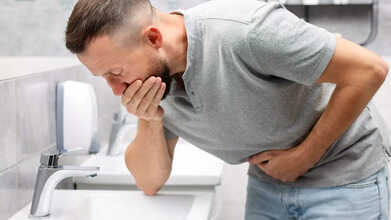- Health Conditions A-Z
- Health & Wellness
- Nutrition
- Fitness
- Health News
- Ayurveda
- Videos
- Medicine A-Z
- Parenting
Can You Fasten Your Healing Process Before The Surgery?

Credit-Canva
In life, one of the first things you are taught is how to take care of a wound. Even if you are not hurt, learning first aid is important as you can be prepared for the worst when the situation arises. Often before a game, people are prepped with medication to make the process smoother. But can you apply the same logic in healing from surgery? Sometimes people ‘pre-game’ certain things like, they eat fever medication before the fever reaches its peak and nip it in the bud. Sports people warm-up before a game to make sure their body is in game mode, even before the game starts. Similarly, we have prehab or prehabilitation to help your body recover better.
Prehab is like getting your body ready for a big event, like a sports game or a race. In this case, the big event is surgery. It's about doing things before your surgery to help you recover faster and easier. Instead of just thinking about getting better after surgery, prehab is about making your body strong and healthy before you go under the knife. This might mean changing what you eat, exercising more, and even getting more support from friends and family. The goal is to make your body as tough as possible so it can handle the surgery better and heal quickly. It's like training for a marathon – you wouldn't just show up on race day without practicing!
What Did the Study Show?
A recent study published in the BMJ researchers looked at lots of different studies about prehab, including almost 16,000 patients. The researchers found that people who exercised regularly before their surgery had a much lower chance of having problems compared to people who didn't exercise. People who ate healthily had a lower risk too, and the people who did both exercise and ate well, and had good social support had the lowest risk of all. The study also showed that prehab could help people leave the hospital a day or two earlier. While the study had some limitations, like some of the studies only looked at one hospital, the results are really promising and suggest that prehab can be a big help for people having surgery.
How Does Prehab Help?
Prehab helps by making you healthier overall before your surgery. This can involve a few important things. Regular exercise makes your heart stronger, builds your muscles, and gives you more energy. Eating healthy foods gives your body the good stuff it needs to work well and heal. And having people who care about you and support you can make you feel less stressed and more positive, which also helps you recover. By doing these things before surgery, you can lower your chances of having problems and might even be able to leave the hospital sooner. It's all about giving your body the best chance to get better quickly.
Making Your Own Prehab Plans
The best prehab plan is one that's made just for you. You need to talk to your doctor and other people on your healthcare team to get their advice. They know what kind of surgery you're having, what your health is like, and other important things. Your prehab plan might include changes to your diet, like eating more of certain foods, and an exercise plan.
While the big study looked at lots of different kinds of surgeries, other studies have looked at specific surgeries and types of people. For example, a study published in the JAMA network showed that prehab is really good for people having bone and joint surgery, helping them move better, feel better, and get stronger. Other studies have found that prehab helps people with certain kinds of cancer surgery recover faster. But one study that looked at older adults found that prehab, while helpful, didn't make a huge difference in muscle strength. This means it's really important to have a prehab plan that's right for you.
Winter Vomiting Disease On The Rise In The US: How To Disinfect After Norovirus

Credits: Canva
Norovirus, often called the “stomach flu” or “winter vomiting illness,” is currently circulating in California and across the United States. Health experts say proper cleaning and disinfecting can slow its spread. These precautions matter because norovirus is extremely contagious and there is no specific treatment for it, according to the Centers for Disease Control and Prevention.
Between August 1 and November 13, health officials recorded 153 norovirus outbreaks across 14 states. The CDC defines an outbreak as two or more similar illnesses linked to suspected or lab-confirmed norovirus cases. Although California is not among the states reporting outbreaks, CDC data shows a noticeable rise in positive norovirus tests throughout November across the western US.
What Is Norovirus?
Norovirus is described as a “highly contagious” virus that causes vomiting, diarrhea, and stomach cramps, according to the California Department of Public Health. It leads to acute gastroenteritis, which means inflammation of the stomach or intestines, and affects people of all ages, the CDC said.
Despite its nickname, norovirus has nothing to do with influenza. The flu is caused by the influenza virus, not norovirus, the agency clarified.
Winter Vomiting Disease: How Does The Stomach Bug Spread?
Norovirus spreads easily from person to person, especially while someone is actively sick, according to the California Department of Public Health. Symptoms usually last one to three days, but a person can still spread the virus for up to two days after they start feeling better.
The virus is present in vomit and stool and can spray into the air or settle on nearby surfaces. It can survive for weeks on uncleaned items such as countertops, phones, and doorknobs, the department said.
“You can get sick after touching or caring for someone who is sick, or after touching or eating something that is contaminated,” the department noted.
Norovirus spreads quickly in crowded or enclosed settings, including schools, child care facilities, hospitals, nursing homes, jails, and cruise ships.
According to state and federal health officials, the most common ways people catch norovirus include:
- Touching, caring for, or sharing food with someone who has norovirus
- Eating or drinking contaminated food or beverages, including undercooked shellfish like oysters
- Touching a contaminated surface and then touching your mouth before washing your hands
- Sharing a toilet or bathroom with someone who is sick
- Swallowing contaminated water, including water from swimming pools or recreational areas
- Cleaning up vomit or diarrhea without protective gear, such as gloves or a face mask
Do You Need To Disinfect After Norovirus?
“If you or someone in your household has norovirus, it’s important to clean and disinfect areas where vomiting or diarrhea occurred,” the California Department of Public Health advised. Cleaning with soap and water removes germs, while disinfecting kills those that remain.
You can use commercial disinfectants, but it’s important to read the label and make sure norovirus is listed among the germs it targets. You can also check the Environmental Protection Agency’s registration number and confirm it appears on the EPA’s List G, which includes products proven effective against norovirus.
Another option is making a bleach solution at home. The US Department of Agriculture recommends mixing 5 to 25 tablespoons of household bleach with one gallon of water. This solution should be used only on hard or nonporous surfaces and applied with a spray bottle or disposable mop, sponge, or paper towel. Let it sit for about five minutes before wiping it away.
The USDA also advises paying close attention to frequently touched items such as doorknobs, handles, and remote controls. Many disinfectant wipes do not fully kill norovirus, the agency warned.
How To Disinfect After Norovirus?
The CDC recommends wearing rubber or disposable gloves while cleaning. Use paper towels to wipe the affected area completely, then place the towels in a plastic trash bag. The California Department of Public Health also suggests wearing a face mask.
After disinfecting, clean the area again with soap and water, the CDC said. Keep in mind that vomit can aerosolize the virus, meaning surfaces several feet away may also be contaminated, according to the USDA.
Once you’re done, throw away the gloves and mask, then take out the trash, the California Department of Public Health advised.
Taking Statins Or Amlodipine? UK Health Experts Issue New Medication Warning

Credits: Canva
Millions of people across the UK who take certain everyday medicines are being warned by the NHS to steer clear of a specific fruit. Health officials say combining this fruit or its juice with some medications can trigger serious reactions and unexpected side effects. The advice applies to patients prescribed some of the most commonly used drugs in the country, including certain statins, amlodipine, and medicines for anxiety. Statins, in particular, are widely prescribed to help reduce levels of “bad” LDL cholesterol in the blood.
Why Statins Are Commonly Prescribed?
Statins work by limiting how much cholesterol the liver makes. This helps slow down the build-up of fatty deposits inside the arteries, which in turn lowers the risk of heart attacks and strokes. Doctors prescribe statins both to manage high cholesterol and to prevent future heart-related problems. For most people, they are taken daily as tablets and are often part of long-term treatment.
What Does Amlodipine Do?
Amlodipine, commonly sold under the brand name Istin, belongs to a group of medicines known as calcium channel blockers. It is mainly used to treat high blood pressure. For people with hypertension, amlodipine can reduce strain on the heart and lower the risk of serious complications such as heart disease, heart attacks, and strokes.
NHS Warning On Statins Or Amlodipine
Patients taking certain forms of amlodipine, particularly calcium channel blockers, are advised not to consume grapefruit. The NHS website clearly states: “Do not take amlodipine with grapefruit juice.”
The reason lies in how grapefruit affects the body. It interferes with enzymes and transport proteins in the gut, such as CYP3A4 and P-gp, which normally help break down medicines and control how much enters the bloodstream. When these processes are blocked, higher-than-intended amounts of the drug can build up in the body, increasing the risk of side effects.
What Patients Should Keep In Mind
Not every medicine reacts the same way to grapefruit juice, which is why doctors advise checking before making changes. Always speak to your GP or pharmacist, read the information leaflet that comes with your medicine, and look out for any warnings related to grapefruit.
It is also important to understand that simply spacing the fruit and the medicine apart is not enough. In most cases, grapefruit should be avoided entirely for as long as you are on the medication, unless your doctor says otherwise. Patients are also encouraged to be cautious with other citrus fruits, such as Seville oranges, pomelos, and limes, as they can have similar effects on how medicines work.
What To Do If You’ve Already Consumed It?
If you have eaten grapefruit or had its juice while taking statins, amlodipine, or anti-anxiety medication, there is no need to panic. In many cases, a single exposure does not lead to serious harm, but it is important to stay alert. Pay attention to how your body feels over the next day or two, especially if you notice symptoms such as dizziness, muscle pain, unusual tiredness, nausea, flushing, or a sudden drop in blood pressure.
Do not stop taking your medication on your own. Skipping doses or stopping treatment abruptly can be risky, particularly for heart and blood pressure medicines. Instead, make a note of what you consumed and when, and contact your GP or pharmacist for advice. They can tell you whether any action is needed based on the specific drug, dose, and your overall health.
Holiday Heart Syndrome Explained: Causes, Symptoms, And How To Stay Safe

Credits: Canva
During the festive months, overindulgence in celebrations can trigger holiday heart syndrome (HHS), a potentially serious yet largely preventable set of heart-related symptoms that tend to rise during this time of year. Most people recover within a day, but HHS can occasionally lead to stroke, heart attack, or other serious complications, according to the Cleveland Clinic. As the holiday season approaches, let’s explore what holiday heart syndrome is, its symptoms, and how to prevent it.
What Is Holiday Heart Syndrome?
First identified by a US physician in 1978, holiday heart syndrome describes irregular heartbeats that occur after binge drinking during the festive season. Research from the University of South Australia shows that alcohol consumption increases by 70 per cent in December compared to other months, while iSelect data predicts Australians may consume around 58 million standard drinks per day during the month. With numbers like these, some caution is warranted.
Atrial fibrillation (AFib) is the specific irregular heartbeat seen in HHS. It occurs when the heart’s upper chambers contract or quiver in a chaotic pattern, which can cause blood to pool in the atrium and form clots. If these clots enter the bloodstream, they can travel to the brain and trigger a stroke.
What Are the Symptoms of Holiday Heart?
Symptoms can include fatigue, dizziness, shortness of breath, anxiety, weakness, confusion, sweating, faintness, unusual tiredness during exercise, rapid or irregular heartbeat, and sensations like fluttering, thumping, pressure, or chest pain.
Dr Mariann R. Piano, Nancy and Hilliard Travis Professor of Nursing at Vanderbilt University School of Nursing, warns, “The scary thing is that people may not notice any symptoms, which makes it a particularly dangerous arrhythmia.”
How Can Drinking Lead to AFib?
Researchers are still investigating exactly how alcohol triggers AFib and how much intake increases the risk. A 2020 study found that people who usually drank at least 10 alcoholic beverages a week lowered their risk of holiday heart syndrome by reducing alcohol consumption. Another study confirmed that eliminating alcohol significantly decreases the chances of developing AFib.
How To Try to Avoid Holiday Heart Syndrome
The Australian Alcohol Guidelines recommend that healthy adults limit alcohol to no more than 10 standard drinks per week to reduce risk.
Experts like Kistler suggest that people with existing heart arrhythmias either abstain or stick to “up to three standard drinks a week.” Drinking mindfully, reducing overall consumption, and staying well hydrated can also help protect your heart.
Tips To Keep Your Heart Healthy During Holidays
Here are some practical ways to protect your heart during the festive season:- Eat smaller, balanced meals and avoid heavy late-night feasts.
- Limit alcohol intake and stay hydrated.
- Continue regular medications without interruption.
- Stay warm and avoid sudden exposure to cold temperatures.
- Maintain light physical activity and avoid strenuous exertion in the early morning.
- Manage stress by taking breaks, sleeping adequately, and avoiding overexertion during travel or celebrations.
- Seek medical help immediately if you experience chest discomfort, unusual fatigue, breathlessness, or palpitations.
© 2024 Bennett, Coleman & Company Limited

